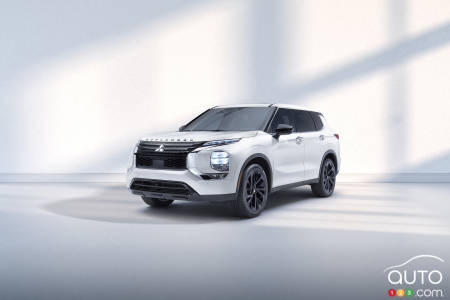During the month of August, we’re getting to know the Mitsubishi Outlander PHEV 2024 better. This is the second chapter of our long-term test of the popular plug-in SUV.
See: 2024 Mitsubishi Outlander PHEV Long-Term Review, Part 1: What's the Story?
Today we look at the appearance and format of the Mitsubishi Outlander PHEV.
We left off last time by pointing out the kinship between the Mitsubishi Outlander (gasoline and PHEV) and the Nissan Rogue. That of course arises from the partnership first entered into by the two Japanese automakers and France's Renault back in 2016.
Actually, the flirtation between Nissan and Renault dates back to 1999. When Nissan subsequently acquired a 34-percent stake in Mitsubishi in 2016, it offered the small Japanese automaker a seat at the table of what became known as the Alliance.
We all know about the earthquake that shook that Alliance two years later. Top man Carlos Ghosn was imprisoned in Japan before fleeing to Lebanon, where he is now holed up. But the triumvirate is still going strong, although it was thoroughly revised last year to give each partner greater freedom of action.
That freedom is such that there are reports that Nissan and Mitsubishi are on the verge of an agreement with Honda for the development of electric vehicles and related software, one of Mitsubishi's strengths.
While all this has been going on, some of it worthy of a spy movie, it was decided that the Alliance would save quite a few dollars/euros/yen if the Outlander borrowed the Rogue's platform. And so it did.
Not just the platform, mind you, but also several other structural and cabin elements (more on this later). The wheelbases of the two compact SUVs are also similar. And yet, visually the two vehicles bear no resemblance to each other. On both sides, designers and engineers took care to distinguish their offering from the other. What's more, although these SUVs are built in Japan, they are produced in different factories.
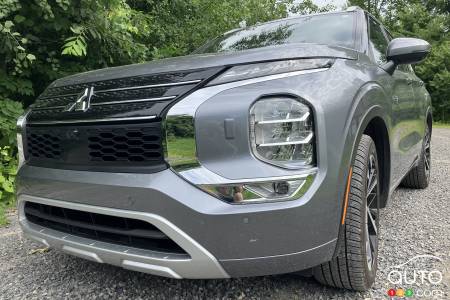
A distinctive look
So place the Nissan and Mitsubishi side by side, there’s no confusing them. What's more, the Outlander PHEV's look has been reworked for its second generation, introduced for the 2023 model-year (one year after the gasoline-powered model).
Of all the components of its body, the grille is undoubtedly the most eye-catching. Most will either love it or cringe. The snout is shall we say, voluminous, and it features a number of horizontal strata which, in turn, are flanked by headlamps unique in the industry. Huge, recessed and encircled by chrome, to these eyes those peepers have always had something amphibious about them.
Although this is purely subjective, I think the Outlander is beautiful. It combines power and elegance. When you spot one in the sea of SUVs, it stands out for all the right reasons.
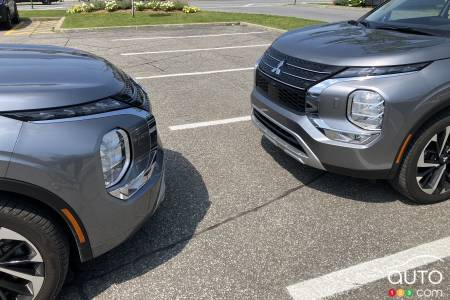
The portfolio
Until now, the Outlander PHEV has been available in five versions: ES, LE, SEL, GT and GT Premium (the gasoline model also incorporates the SE variant). Now, for the 2024 model-year, the automaker is adding a Black Edition to the range.
If you’ve been paying attention, you’ll know the idea of blacking out body components is a trendy one in the industry. Mitsubishi has obviously notices as well. In the case of the Outlander PHEV, rims, nuts, grille, door mirrors and mouldings are all black, while the cabin gets darkened headlining and grey stitching. Why not!
According to Maxime Dubuc, Sales Manager at Mitsubishi Boucherville, this coquetry adds some $2,000 to the bill. “This BLACK package,” he explains,” applies to the GT model. Basically, an Outlander PHEV GT Black Edition now surpasses the GT Premium in the hierarchy.”
By the way, since we’re on the aesthetics, you might ask what are the exterior features that distinguish the PHEV from the gas-only model. Just as I was pondering that question myself, I pulled into a parking lot where sat an Outlander that looked identical to mine.
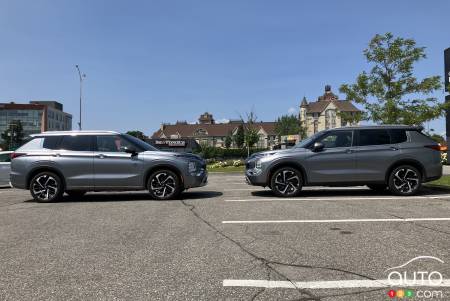
I stopped my vehicle in front of its twin and inspected the duo in the company of a fellow by the name of Yvan, who was getting out of his Honda Accord Hybrid right then. Intrigued by what I was up to and a great car enthusiast, he joined me in playing a quick Spot the Differences game.
We only found two, namely the two PHEV badges on my model. Other than that, the two SUVs were identical twins.
Compact or mid-size?
In automotive literature, the Outlander is generally regarded as a compact vehicle. But it boasts the ability to carry up to seven occupants, and that capacity could distort the picture in people's minds. If it's so roomy, it must be big!
Well, let's let the numbers tell the story (in mm):
- - Length: 4710
- - Width: 1897 (35 less for the PHEV, for some reason)
- - Height: 1745 (on 18-in wheels, otherwise 3 mm more with 20-in wheels)
- - Wheelbase: 2706
If we randomly choose four rivals considered compact SUVs, say the Ford Escape PHEV (1), the Kia Sportage PHEV (2), the Toyota RAV4 Prime (3) and, of course, the Nissan Rogue (4), here’s what we get:
- - Length: 4585 (1) / 4660 (2) / 4595 (3) / 4648 (4)
- - Width: 1882 (1) / 1865 (2) / 1855 (3) / 1840 (4)
- - Height: 1679 (1) / 1665 (2) / 1701 (3) / 1689 (4)
- - Wheelbase: 2710 (1) / 2755 (2) / 2690 (3) / 2706 (4)
Here’s what all that tells us. In terms of overall size, all these SUVs are essentially the same, give or take a few millimetres. We note that the Outlander is longer, wider and taller than the other three, but its wheelbase is slightly shorter – except for the Toyota and the Rogue (inevitably in the latter case, since the models are built on the same platform).
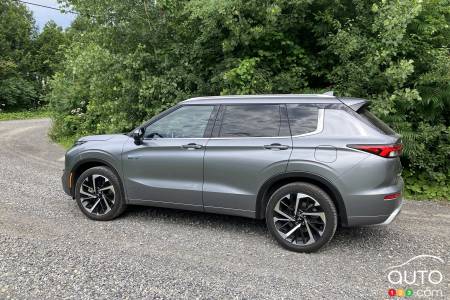
Wheelbase is the measurement (calculated from axle to axle) that affects the amount of space available to occupants. Interestingly, of the five SUVs compared, only the Outlander offers a third row of seats, even though its wheelbase isn't all that generous. In other words, when you read later that the Mitsubishi's third-row seats are cramped, you'll understand why.
You generally have to look to mid-range SUVs to find a third row. Cases in point, the Hyundai Palisade/Kia Telluride duo, the Mazda CX-90 and the Chevrolet Traverse. With these vehicles, wheelbase doesn't dip below 2,900 mm.
There is one exception. The Volkswagen Tiguan, considered a compact SUV, offers a third row of seats; but its length and especially its wheelbase (2790 mm) surpass those of the Outlander PHEV.
In short, despite its seven seats, we can indeed consider the Outlander a compact SUV. Though a “bigcompact”...
